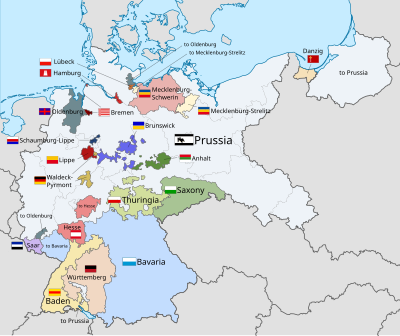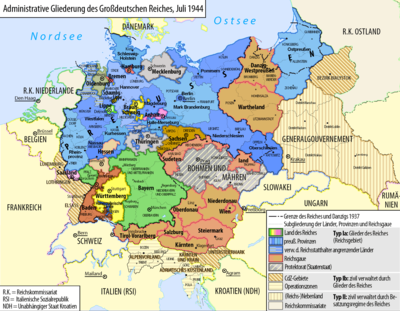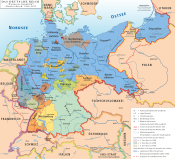The Nazi term Gleichschaltung or "coordination" was the process of Nazification by which Adolf Hitler and the Nazi Party successively established a system of totalitarian control and coordination over all aspects of German society and societies occupied by Nazi Germany "from the economy and trade associations to the media, culture and education". Although the Weimar Constitution remained nominally in effect until Germany's surrender following World War II, near total Nazification had been secured by the 1935 resolutions approved during the Nuremberg Rally, when the symbols of the Nazi Party and the state were fused and German Jews were deprived of their citizenship.
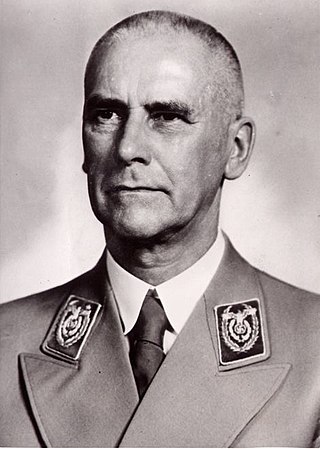
Wilhelm Frick was a prominent German politician of the Nazi Party (NSDAP), who served as Minister of the Interior in Adolf Hitler's cabinet from 1933 to 1943 and as the last governor of the Protectorate of Bohemia and Moravia.

Reichsgau Danzig-West Prussia was an administrative division of Nazi Germany created on 8 October 1939 from annexed territory of the Free City of Danzig, the Greater Pomeranian Voivodship, and the Regierungsbezirk West Prussia of Gau East Prussia.
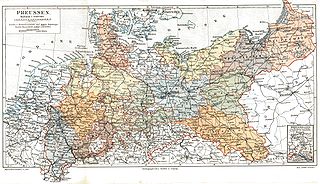
The Provinces of Prussia were the main administrative divisions of Prussia from 1815 to 1946. Prussia's province system was introduced in the Stein-Hardenberg Reforms in 1815, and were mostly organized from duchies and historical regions. Provinces were divided into several Regierungsbezirke, sub-divided into Kreise (districts), and then into Gemeinden (townships) at the lowest level. Provinces constituted the highest level of administration in the Kingdom of Prussia and Free State of Prussia until 1933, when Nazi Germany established de facto direct rule over provincial politics, and were formally abolished in 1946 following World War II. The Prussian provinces became the basis for many federal states of Germany, and the states of Brandenburg, Lower Saxony, and Schleswig-Holstein are direct successors of provinces.

The Reichsrat of the Weimar Republic was the de facto upper house of Germany's parliament; the lower house was the popularly elected Reichstag. The Reichsrat's members were appointed by the German state governments to represent their interests in the legislation and administration of the nation at the federal level. Its powers were relatively limited, making it considerably weaker than its predecessor, the Bundesrat of the German Empire (1871–1918). It could introduce legislation for the Reichstag to consider and veto laws that it passed, but the vetoes could be overridden. The Reichsrat also played a role in administering and implementing Reich laws.

Ostmark was a name that referred historically to the Margraviate of Austria, a medieval frontier march. It was also used in Nazi propaganda from 1938 to 1942 to refer to the formerly independent Federal State of Austria after the Anschluss with Nazi Germany. From the Anschluss until 1939, the official name used was Land Österreich.

A Reichsgau was an administrative subdivision created in a number of areas annexed by Nazi Germany between 1938 and 1945.

Gau is a Germanic term for a region within a country, often a former or current province. It was used in the Middle Ages, when it can be seen as roughly corresponding to an English shire. The administrative use of the term was revived as a subdivision during the period of Nazi Germany in 1933–1945. It still appears today in regional names, such as the Rheingau or Allgäu.

The Reichsstatthalter was a title used in the German Empire and later in Nazi Germany.

The Gaue were the main administrative divisions of Nazi Germany from 1934 to 1945.

The Free State of Prussia was one of the constituent states of Germany from 1918 to 1947. The successor to the Kingdom of Prussia after the defeat of the German Empire in World War I, it continued to be the dominant state in Germany during the Weimar Republic, as it had been during the empire, even though most of Germany's post-war territorial losses in Europe had come from its lands. It was home to the federal capital Berlin and had 62% of Germany's territory and 61% of its population. Prussia changed from the authoritarian state it had been in the past and became a parliamentary democracy under its 1920 constitution. During the Weimar period it was governed almost entirely by pro-democratic parties and proved more politically stable than the Republic itself. With only brief interruptions, the Social Democratic Party (SPD) provided the Minister President. Its Ministers of the Interior, also from the SPD, pushed republican reform of the administration and police, with the result that Prussia was considered a bulwark of democracy within the Weimar Republic.

The Republic of Baden was a German state that existed during the time of the Weimar Republic, formed after the abolition of the Grand Duchy of Baden in 1918. It is now part of the modern German state of Baden-Württemberg.

The Free State of Schaumburg-Lippe was created following the abdication of Prince Adolf II of Schaumburg-Lippe on 15 November 1918, following the German Revolution. It was a state in Germany during the Weimar Republic and Nazi Germany. The democratic government was suppressed during Nazi rule. At the end of the Second World War, the British military occupation government decreed on 1 November 1946 the union of Schaumburg-Lippe, Hannover, Braunschweig and Oldenburg to form the new state of Lower Saxony.
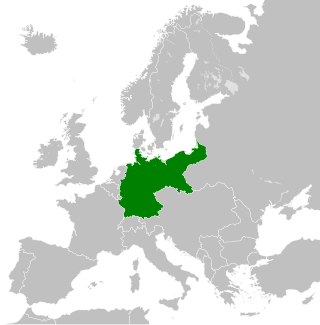
The territorial evolution of Germany in this article include all changes in the modern territory of Germany from its unification making it a country on 1 January 1871 to the present although the history of "Germany" as a territorial polity concept and the history of the ethnic Germans are much longer and much more complex. Modern Germany was formed when the Kingdom of Prussia unified most of the German states, with the exception of multi-ethnic Austria, into the German Empire. After the First World War, on 10 January 1920, Germany lost about 13% of its territory to its neighbours, and the Weimar Republic was formed two days before this war was over. This republic included territories to the east of today's German borders.

The Free State of Lippe was created following the abdication of Prince Leopold IV of the Principality of Lippe on 15 November 1918, following the German Revolution. It was a state in Germany during the Weimar Republic and Nazi Germany. After the end of the Second World War, the Control Commission for Germany – British Element (CCG/BE) abolished the state of Lippe in January 1947 and incorporated it into the new German state of North Rhine-Westphalia that had been created three months earlier.
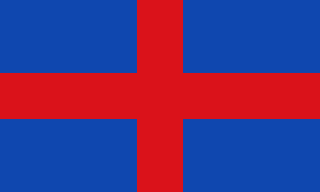
The Free State of Oldenburg was a federated state that existed during the Weimar Republic and Nazi Germany. It was established in 1918 following the abdication of the Grand Duke Frederick Augustus II after the German Revolution and was abolished by the Allies following the Second World War.

Chief of Civil Administration was an office introduced in Nazi Germany, operational during World War II. Its task was to administer civil issues according to occupation law, with the primary purpose being the support of the military command in the operational areas of the German Army. CdZ would pass his authority to a corresponding civil government after the territory in question became in the rear of the operating armed forces.
The Provisional Law and Second Law on the Coordination of the States with the Reich were two laws enacted by the German government of Adolf Hitler to expand its control over the seventeen German states (länder). The Provisional (First) Law dissolved all the sitting landtage, except for that of Prussia, and reconstituted them in accordance with the results of the recent parliamentary election of 5 March 1933, which had given the Nazi Party and its coalition partner, the German National People's Party (DNVP), a majority of the Reichstag seats. The Second Law established the new powerful position of Reichsstatthalter appointed by the central government to effectively take control of each state administration. The effect of these laws was to undermine the power and influence of all political parties other than the Nazis and the DNVP, and to move Germany significantly away from being a federal republic and put it on a path to becoming a unitary state.
The Law on the Reconstruction of the Reich of 30 January 1934, was a sweeping constitutional change to the structure of the German state by the government of Nazi Germany. It was one of the key pieces of legislation that served as the basis for the policy of Gleichschaltung, or coordination, by which Adolf Hitler and the Nazi Party successfully established their totalitarian control over all aspects of the German government and society. The law abolished the independent parliaments (Landtage) of the then-extant 16 German states, transferred the states' sovereignty to the central government and essentially converted Germany from a federal republic to a unitary state.
The Law on the Abolition of the Reichsrat was a measure enacted by the government of Nazi Germany on 14 February 1934 that abolished the second chamber of the German parliament.
